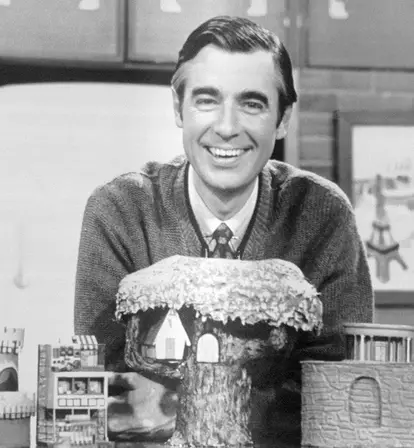Fred Rogers, known as Mister Rogers, originally planned to become a Presbyterian minister. But he realized his true calling was teaching children how to love each other — and themselves.
If you’re one of the millions of Americans who grew up watching Fred Rogers on Mister Rogers’ Neighborhood, you may have heard some rumors about his darker past.
Ever hear about his time in the Marines as a sniper, when he recorded 150 “kills” he made during the Vietnam War? How about the secret “tattoos” on his arms that he hid with sweaters? Or maybe you’ve seen the infamous GIF of Mister Rogers joyfully flipping kids off — and wondered if it was real.
As intriguing as these stories may be, all of them are urban legends. He never served in the military. He had zero tattoos. And for the folks who can’t let the GIF go, the meme has an innocent explanation.
As it turns out, the video was captured at just the right moment during a wholesome game of “Where is Thumbkin?” So yes, he technically gave the double bird — but only to teach kids about which fingers are which.
Why is Mister Rogers a target for these unfounded stories? Maybe it’s because people find it difficult to believe that someone can be as good as he appeared to be — and by all accounts actually was.
Who Was Mister Rogers?
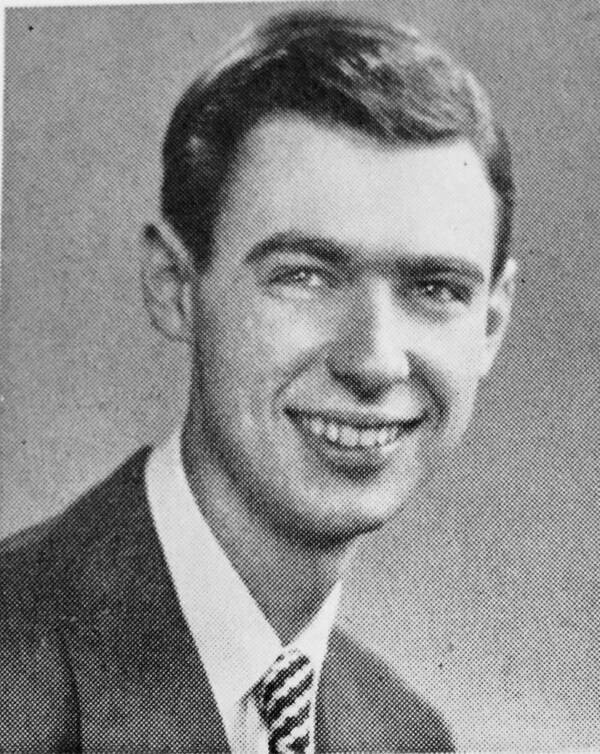
Wikimedia CommonsFred Rogers’ high school yearbook photo, 1946.
Fred McFeely Rogers was born on March 20, 1928, in the small industrial town of Latrobe, Pennsylvania, near Pittsburgh. His childhood was not a particularly happy one. He suffered from asthma, and he was often bullied because he was a chubby kid.
Children would taunt him, saying, “We’re going to get you, Fat Freddy.” But the harassment was also a defining moment for Fred Rogers. He vowed to look past people’s physical shortcomings to find the “essential invisible,” as he called it, that lay beneath.
He played with puppets not just for fun, but also to help him work out his anxiety. As a loner, he played the piano and the organ and then started to compose songs. He would go on to create more than 200 tunes in his lifetime.
After high school, Fred Rogers left his hometown for his first year of university at Dartmouth College in New Hampshire. Then he transferred to Florida’s Rollins College and graduated magna cum laude in music composition in 1951. Rollins College was also where he met his future wife, Joanne Byrd, whom he married on June 9, 1952.
He planned to attend a seminary after school, but his first exposure to television changed his mind. As he put it: “I saw people throwing pies in each other’s faces, and I thought: This could be a wonderful tool for education! Why is it being used this way?”
So Fred Rogers told his parents that he was putting his plans to become a Presbyterian minister on hold in order to pursue a career in television. After a short stint at NBC, he was hired by WQED-TV in Pittsburgh to write and produce The Children’s Corner with Josie Carey, the show’s host.
That local show was where he developed many of the puppets that would later become regulars on Mister Rogers’ Neighborhood, including Daniel the Striped Tiger, X the Owl, Lady Elaine Fairchilde, and King Friday XIII.
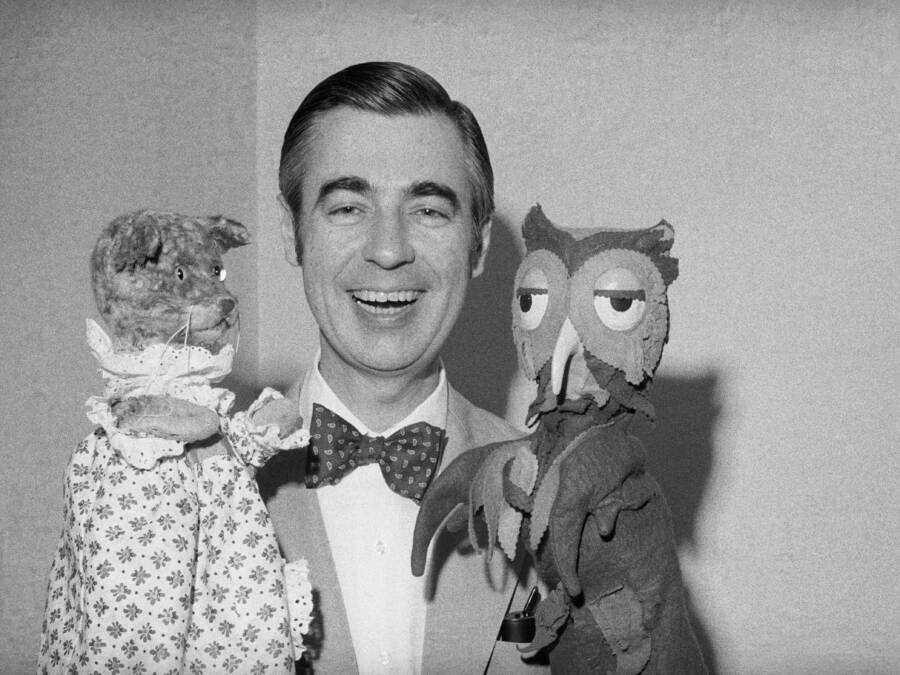
Bettmann/Getty ImagesFred Rogers holds two of his puppets, Henrietta Pussycat and X the Owl.
He continued studying theology part-time, earning his divinity degree in 1962. Although he did become ordained to serve as a minister, he continued to pursue his dream of educating children through television.
In 1963, Rogers appeared on camera for the first time as the host of Misterogers, a 15-minute Canadian children’s show, which became yet another testing ground for ideas and the development of set pieces used later in Mister Rogers Neighborhood.
In 1966, Rogers, armed with the rights to his CBC show, returned to Pittsburgh to create Mister Rogers’ Neighborhood — which was a regional show at first. Just two years later, the show was broadcast nationally on what would later become the Public Broadcasting Service, or PBS.
The Success Of Mister Rogers’ Neighborhood

Wikimedia CommonsMister Rogers, pictured in the late 1960s.
Mister Rogers’ Neighborhood was one of the longest-running television shows ever, with more than 900 episodes airing over 33 years. The final episode was broadcast in August 2001, but it has since lived on in reruns.
Fred Rogers literally was the show. He produced, hosted, wrote the scripts, and composed the music. The tunes played a vital, soothing role and each episode was structured like a musical composition.
A key aspect of Mister Rogers’ Neighborhood was the low-key and evenly-paced format, which was in stark contrast to the approaches of other kids’ shows. There were no special effects or animations to speak of. Instead, Rogers relied on his puppets, a cardboard castle, and thoughtful one-on-one talks with guests.

Wikimedia CommonsMister Rogers’ trolley would take viewers from Rogers’ home to the puppet-populated Neighborhood of Make-Believe.
Mister Rogers was serious about fostering self-esteem, tolerance, creativity, kindness, and empathy in his young viewers. A number of his ideas were drawn from child-rearing principles developed at the time, working with leading child psychologists like Margaret McFarland, who acted as Rogers’ chief advisor on the show until 1988.
Fred Rogers also wanted to foster in children the notion that making mistakes was a part of life. “Fred thought it was important that kids understood that you’ve got to make mistakes so you get better and that making mistakes helps you grow,” said Margy Whitmer, a longtime producer of the show.
Most of all, he respected the children who were watching him from their living rooms. “He made a mass medium personal,” said David Kleeman, the former president of the American Center for Children and Media. “He had a way of talking to the camera as though there was just one child there. And he made every child feel he was speaking directly to them.”
https://www.youtube.com/watch?v=s96HHSSjh4k
Mister Rogers explained the hows and whys of things, like the inner workings of bulldozers or how mushrooms grew. Some of his guests were experts on these subjects and helped explain them in accessible ways.
But he also explored the inner lives of children — especially their feelings and stages of development. Topics ranged from irrational childhood fears like being sucked down the drain in the bath, to coping with the first day of school. Lessons were often performed as songs.

Getty ImagesMister Rogers entertaining children at an event held at the University of South Dakota, 1973.
The Neighborhood Gets Serious
Fred Rogers recognized that some issues that affected children could not be dealt with in a light-hearted way. He faced those hard-hitting events — like parental divorce and the loss of a beloved pet — head-on.
“I know a little girl and a little boy whose mother and father got a divorce,” he said in one episode. “And those children cried and cried. You know why? Well, one reason was that they thought it was their fault. But of course, it wasn’t their fault. Things like weddings and having babies and buying houses and cars and getting divorces are all grown-up things.”
Time magazine referred to those episodes as “the darkest work of popular culture made for preschoolers since perhaps the Brothers Grimm.”
Fred Rogers also used his show as a platform to fight for equality. In one 1969 episode, Mister Rogers and his frequent guest star, “Officer” François Clemmons, a black man, soaked their feet in the same kiddie pool. You wouldn’t bat an eye now, but back in the late 60s, at the height of the desegregation movement, that simple act made a powerful statement.

Getty ImagesMister Rogers believed in addressing tough topics directly, but in a kind, gentle way.
On top of that, Mister Rogers didn’t shy away from medical conditions that could affect children. Instead, he tried to help his viewers understand them.
In an episode from 1981, Rogers interviewed Jeffrey Erlanger, a 10-year-old quadriplegic, and got him to demonstrate how his wheelchair worked. Rogers really wanted the children watching to see how comfortable Erlanger was talking about his condition.
To Rogers, these difficult subjects needed to be talked about with children, not ignored. But these topics were always delivered with sincerity and in a kind, gentle way. He earned millions of fans across America as a result.
However, a lot of people also poked fun at him for his earnest nature. Comedians like Eddie Murphy often lampooned him. Sometimes these parodies hurt Rogers, but Johnny Carson reassured him it was done out of fondness rather than malice.
When Murphy finally met Rogers, all he wanted to do was hug him.
Lawsuits, Senate Hearings, And Saving The VCR
https://www.youtube.com/watch?v=J9uIJ-o2yqQ
Despite his mild manner, Fred Rogers was no pushover. When Burger King used a lookalike to sell fast food to kids in a commercial in 1984, Rogers demanded they remove the ads, which they did. In 1990, he sued the Ku Klux Klan for using imitations of his voice and the Mister Rogers’ Neighborhood theme song in racist telephone calls.
But his biggest coup came when he singlehandedly defended the funding of television itself. In 1969, Rogers addressed the Senate to convince them not to cut a $20 million grant to PBS. At the time, he was relatively unknown.
Fred Rogers demonstrated that his nice-guy approach could be just as persuasive with senators as it was with children. He spoke frankly about the erosion of values through violent television programming and the need to protect and educate children.
“We deal with such things as the inner drama of childhood,” he told the senator. “We don’t have to bop someone over the head to make drama. We deal with such things as getting a haircut. Or the feelings about brothers and sisters, and the kind of anger that arises in simple family situations. And we speak to it constructively.”
Senator John Pastore, who chaired the hearing, had never heard of Mister Rogers, but after just a six-minute speech, he made sure PBS got to keep their funding.
“I’m supposed to be a pretty tough guy, and this is the first time I’ve had goosebumps for the last two days,” he said. “I think it’s wonderful. Looks like you just earned the $20 million.”
Years later, Mister Rogers went in front of the Supreme Court to save the VCR. There were legal concerns that recording a television show constituted copyright infringement. But Rogers, who always championed families, convinced the justices that the VCR was essential for hard-working parents to sit down with their children and watch shows together as a family.
All of Mister Rogers’ hard work obviously paid off for millions of Americans that benefitted from his words of wisdom. So it’s no surprise that he won a plethora of awards throughout his lifetime, including a Lifetime Achievement Emmy and a Peabody Award.
In 1999, Rogers was finally inducted into the Television Hall of Fame. Even in his acceptance speech, he still expressed concern over how television influenced children at home.
He asked the celebrities in the audience to reflect on their position as people “chosen to help meet the deeper needs of those who watch and listen, day and night.”
The Film A Beautiful Day In The Neighborhood
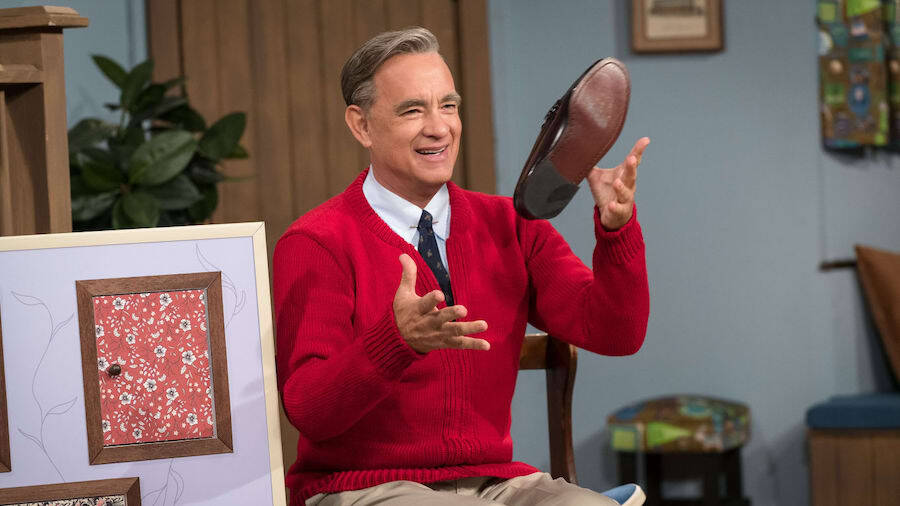
Lacey Terrell/Sony PicturesTom Hanks as Mister Rogers in the movie A Beautiful Day In The Neighborhood.
Mister Rogers’ legacy is celebrated in the film A Beautiful Day In The Neighborhood, set to be released on Nov. 22, 2019. The movie stars Tom Hanks as Fred Rogers.
But don’t mistake this movie for a biopic. Instead, it’s simply inspired by the real-life friendship between Mister Rogers and Tom Junod — a journalist who profiled the TV icon for Esquire.
Although Junod was cynical at first about interviewing Mister Rogers, his view changed dramatically after he met the beloved celebrity in person. His article ended up being titled: “Can You Say… Hero?”
In a recent piece for The Atlantic, Junod reflects on the life-changing experience of meeting and befriending Mister Rogers:
“A long time ago, a man of resourceful and relentless kindness saw something in me that I didn’t see in myself. He trusted me when I thought I was untrustworthy, and took an interest in me that went beyond my initial interest in him. He was the first person I ever wrote about who became my friend, and our friendship endured until he died.”
In the same article, Junod clarifies a few things about the film: “Now a movie has been made from the story I wrote about him, which is to say ‘inspired by’ the story I wrote about him, which is to say that in the movie my name is Lloyd Vogel and I get into a fistfight with my father at my sister’s wedding. I did not get into a fistfight with my father at my sister’s wedding. My sister didn’t have a wedding.”
“And yet the movie, called A Beautiful Day in the Neighborhood, seems like a culmination of the gifts that Fred Rogers gave me and all of us, gifts that fit the definition of grace because they feel, at least in my case, undeserved,” Junod continues. “I still don’t know what he saw in me, why he decided to trust me, or what, to this day, he wanted from me, if anything at all.”
Interestingly enough, Tom Hanks has also admitted that he wasn’t the biggest Mister Rogers fan when he was growing up. “I was too busy watching Rocky and Bullwinkle, and stuff like that,” Hanks explained to the press at the Toronto International Film Festival.
But a few years ago, the Oscar-winning actor received an email from a friend with an old clip from Mister Rogers’ Neighborhood that instantly changed his mind. The 1981 video showed Mister Rogers greeting Jeffrey Erlanger, the 10-year-old quadriplegic boy in a wheelchair.
“Fred is just so wonderfully gentle and present [with] someone who normally would make [most people] feel uncomfortable,” Hanks said. “What do you say to somebody who will spend their life in a wheelchair? He said, ‘Jeff, do you ever have days when you’re feeling sad?’ He says, ‘Well, yeah, sure Mister Rogers. Some days… but not today.'”
Hanks confessed: “It made me bawl my eyes out. It was just so [amazing]. It’s one of the reasons why I’m in the movie.”
Remembering Mister Rogers And His Legacy
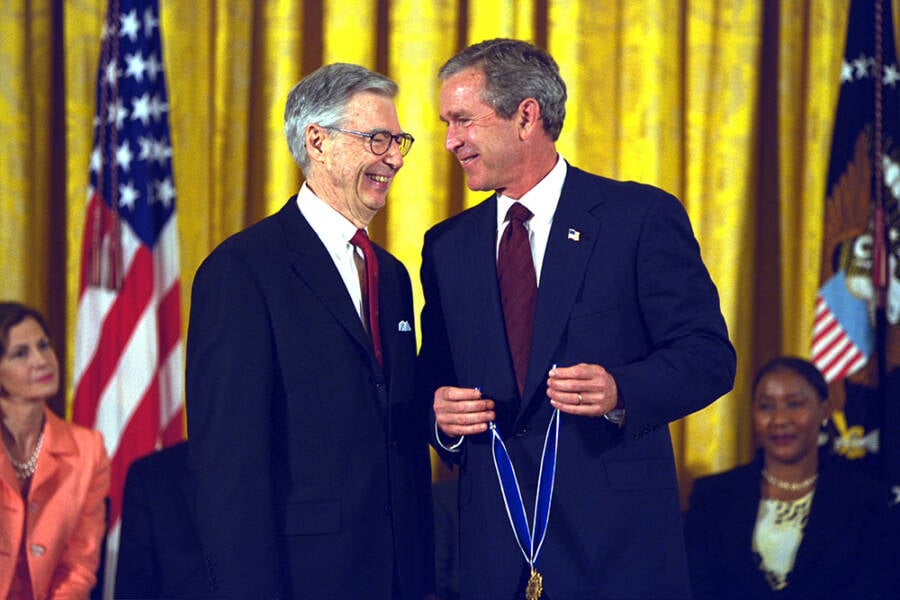
Paul Morse/George W. Bush Presidential Library/Wikimedia CommonsIn 2002, President George W. Bush presented Fred Rogers with the Presidential Medal of Freedom.
Mister Rogers remained married to his wife Joanne for more than 50 years until he died of stomach cancer in February 2003. He was 74 years old.
Shortly after his passing, his website provided a link for parents to help them discuss death with their children.
“Children have always known Mister Rogers as their ‘television friend,’ and that relationship doesn’t change with his death,” the site said. “Remember that Fred Rogers has always helped children know that feelings are natural and normal, and that happy times and sad times are part of everyone’s life.”
He is survived by his beloved wife, their two sons, Jim and John, and three grandsons. According to a 2018 article published in the Los Angeles Times, the family still cherishes his memory and values everything he stood for.
“Part of me just went with him,” Joanne, now 91, said. “But I find that he’s with me so much of the time. I can get to him very quickly.”
Meanwhile, John still believes that his father’s morals were “beyond” most people.
“The way he led his life, I believe Dad tried to follow the example of Christ — and did in such a fabulous way,” said John. “So living up to a legend such as he was challenging for me growing up. I had my issues with that.”
“But at about age 30, I sort of came to peace with it. I was like, ‘You know what? I’m happy with myself.’ And what did dad always teach us? ‘Be happy with the way you are.'”
Jim added, “Dad always gave me room to grow. I’ve had a beard and long hair for a pretty long time, and he always thought of that as outside stuff that didn’t really matter.”
Now, with the new film on the horizon, Mister Rogers’ widow and sons are excited to revisit their beloved family member’s legacy — and continue to celebrate him with the rest of the world.
“I think if Dad were alive, he’d probably say, ‘What’s all this hoopla? This is silly,'” Jim said. “But at the same time, I think he’d probably lean back and reflect on a job well done.”
After learning about the life of Mister Rogers, take a look at the first drama ever broadcast on television. Then, learn all about the incredible true story of Charles Van Doren and the quiz show scandals.
